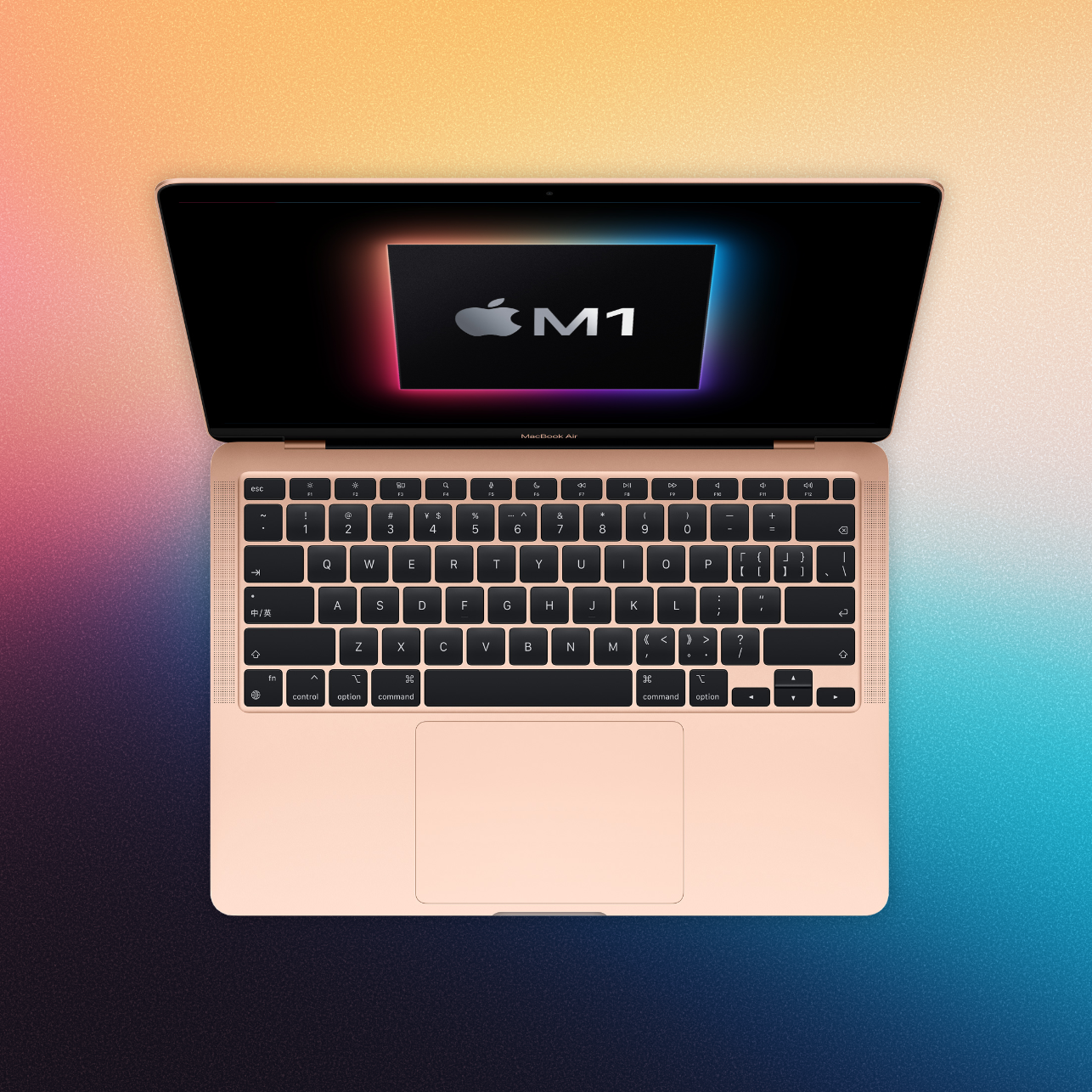M1 Air: First Impressions
I made the move from a 13" MacBook Pro to an M1 MacBook Air last week. Despite being in the minority of people who seem to like the TouchBar, I forfeited it because I couldn't resist the idea that my next Mac wouldn't need an active cooling system. After using the computer for nearly a week, I wanted to jot down my thoughts and impressions on this incredible next generation of Macs.
Stats
Outgoing Model: Mid-2018 13" MacBook Pro
Processor: 8th Generation Intel 2.7 GHz i7
Geekbench: 1011 Single-Core; 3095 Multi-Core
Incoming Model: Late-2020 13" MacBook Air
Processor: Apple M1 Processor
Geekbench: 1689 Single-Core; 7295 Multi-Core
What should immediately stand out is that the single-core performance of the M1 is 67% higher than the i7, while the multi-core score is 235% higher than my outgoing Intel Mac. Both machines had 1TB of SSD, and both were upgraded to include 16GB of memory.
Rambling about M1
Apple announced the transition to its processor architecture, dubbed Apple Silicon, at their virtual WWDC event in late June 2020. In the keynote, we only got a very cursory sense of what Apple Silicon would provide: better performance and lower power consumption. And we were told that the first Apple Silicon Macs would be arriving by the end of 2020, with the transition across the entire product line predicted to take up to two years. Beyond that, it was really up to our wildest imaginations to define what exactly that meant.
Despite few specifics about what Apple Silicon on the Mac would look like, there was a lot to be optimistic about. Apple has been manufacturing their own silicon for over a decade, ever since the company announced the iPad with an A4 chip. And in the decade following A4, Apple has honed its chips to be incredibly powerful but also extremely power efficient. For example, consider Apple's A14 chips in the latest iPad Air and iPhone 12 lineup. These chips outperform any Intel-based Mac in single-core performance (Geekbench: 1584 v. 1250 on the 27" Retina iMac released in 2020) and perform comparably to the mid-2020 13" MacBook Pro with a 2.0 GHz quad-core Intel i5 (Geekbench: 4189 v. 4237 on the MacBook Pro). What's even more remarkable is that these benchmarks are being hit inside a battery-powered mobile device with no active cooling.
When you have these sorts of comparisons swirling around, you begin to get enthused about what Apple Silicon might mean for the Mac. We could compare phones to laptops all we want, but until Apple released their ARM-based processor, we didn't have a true Apples-to-Apples (pun intended) comparison for how a Mac running on Apple Silicon would perform.
Then on November 10, Apple announced the M1 processor and its first wave of new Macs - the MacBook Air, 2-Port 13” MacBook Pro, and Mac mini. The keynote flashed a few graphs touting a 2-3x performance improvement over their existing products and 18-20 hours of battery life. But this isn't my first Rodeo; we all know companies highlight the most favourable stats in the most favourable conditions to paint their products in the most favourable light. The numbers certainly seemed impressive, but it was the first impressions and early reviews I was waiting on to get a sense of what M1 would be like. What came next was far beyond anything I was expecting
To a man, every reviewer was stunned by M1. Not just impressed, not just surprised, stunned! The M1 broke the Apple tech community by delivering performance and battery life few could fathom. When was the last time you saw the entire tech community collectively shook by how great a new piece of tech is!?
And remember, these are the entry-level Macs... these are Apple's cheapest, slowest computers... and they're performing so favourably in many demanding tasks (Final Cut, Xcode compiling) that people are contemplating switching from iMac Pros or 16" MacBook Pros. M1 Broke the internet.
First Impressions
I’M A FAN
Ever since Apple announced their transition to their silicon, I have been on the edge of my seat for the possible return of a fanless Mac. As demonstrated by the A-Series chips, Apple can do wonders without needing active cooling, so I had high hopes that Apple would flirt with the idea of offering a fanless portable again. I owned, and loved, Apple's first fanless portable, the 12" MacBook, but that computer used a low-grade 1.1 GHz Intel Core-M that significantly compromised speed to offer a fanless architecture. Not so with the M1 processor. Removing the fan from the Air allows it to run completely silent, and this time around, the computer is beyond stacked in performance. The concern with running a computer without active cooling is that it will quickly throttle when hit with performance-heavy tasks. Early reviews showed that intensive tasks needed to run consistently for over 10 minutes before the Air began to clock down its performance to reduce heat. Even then, the performance hit was only around 10-15%.
SO COOL
This computer doesn't get hot. Frankly, this computer doesn't even get warm. I just checked the temperature after nearly two hours of moderate use (watching YouTube videos, writing in iA Writer, and working in Pixelmator), and the computer is at 25.6ºC (78ºF). Last night I worked on a small Final Cut project for about an hour, and the computer eventually crept up to 34ºC (92ºF). I Installed mac0S 11.0.1 this morning (a 20-minute software update), and afterwards, the laptop was completely cool to the touch. That same update on my outgoing Intel MacBook Pro spun the fan up within seconds, and the computer was noticeably warm even as my hand hovered over the keyboard.
ROSETTA 2
Like the transition to Intel, Apple has built a technology (Rosetta 2) that translates x86 code into an ARM binary. One significant difference between Rosetta in 2006 and Rosetta 2 in 2020 is that with Rosetta 2, the binary is created when the app is being installed, rather than being computed in real-time like in 2006. Apart from checking the Get Info panel for an app, I haven't been able to distinguish any performance differences between a Universal app and an Intel-only app translated with Rosetta 2 on M1.
REFERENCE POINT
Just a few days with the Air have spoiled me beyond the point of return. When it came to doing a few tasks on the Intel Pro before selling it off, I couldn't help notice stark differences in performance. Last week, my MacBook Pro felt zippy, but after using the M1 Air for less than a week, the Pro feels like sludge. Except for Microsoft Word or Final Cut Pro, every single app on my M1 Mac loads before the app completes a single bounce in my dock. And every other operation - copying files, opening windows, scrolling - feels noticeably tighter and much more responsive! Once you go M1, you can't go back.
IS THE BATTERY WORKING?
There were several times in the past week when I would check the battery indicator after 20 to 30 minutes of use only to see that it hadn't gone down. The battery life has been so good that I began to worry on a number of occasions if there was something wrong with the battery monitor. I can't overstate how little battery this laptop sips, regardless of what task you throw at it.
iOS APPS ON M1 MACS
Yes, M1 Macs run iOS apps, but it's painfully clear this is currently is not a tent pole feature Apple intends for the Mac. They barely advertise it... seriously, it's like a single slide in their keynote. And currently, many developers have opted out of offering support for iOS apps on M1. Overall, this feels a little half-baked at the moment. I would not rush and get an M1 Mac if this somehow was your main reason for getting one.
GLITCHES
In my week of using M1, I have only come across two minor glitches. The first was that Pixelmator Pro wouldn't download from the App Store, but that was quickly addressed when the company launched V. 2.0 the day after M1 Macs became available. The second is that the Grammarly website will crash Safari every time I try to log into it. But apart from those two glitches, the transition continues to be very smooth. Mind you; I have a pretty basic workflow that doesn't require a lot of niche apps, plugins, or extensions, making my transition to Big Sur & M1 a lot smoother than it might for others. But for the vast majority of users, I expect this transition to be seamless. Apple did replace its most popular Mac, the MacBook Air, with the M1 preinstalled with Big Sur.
UNANSWERED QUESTIONS
These M1 Mac didn't reinvent the wheel with their design. Unless you consider the Mac mini coming in silver again a reinvention, these Macs look the same as their Intel counterparts. But while these first Macs answer a lot of questions about the transition to Apple’s own silicon, questions remain about what redesigns we'll see in the future, how Apple will design chips for Macs requiring higher performance levels, and if a touchscreen or FaceID will ever come to the Mac? I'm also interested to see what Apple's update cycle for its chips will be and how YoY improvements for the M-Series chips will compare with Intel's? For now, these first Macs accomplished what Apple was hoping for: create a lot of confidence for how much better Macs running Apple's silicon would be; humiliating Intel in the process seems like it was just the cherry on top. 🍒
Future of Apple Silicon
Apple wouldn't have announced this transition if it wasn't absolutely confident in what their chips could deliver, but I don't think anyone outside of Apple realized how stunning this first generation of chips would be. Apple overshot any of my wildest hopes & expectations with M1. 2020 is it's the beginning of a very exciting new era for the Mac.
Note: This MacBook has been off battery for 23 consecutive hours. In that time I’ve written this entire post, edited it, created the header image for it in Pixelmator Pro, been on twitter, watch a few YouTube videos, and browsed Safari for over an hour. Current battery remaining: 78%.

